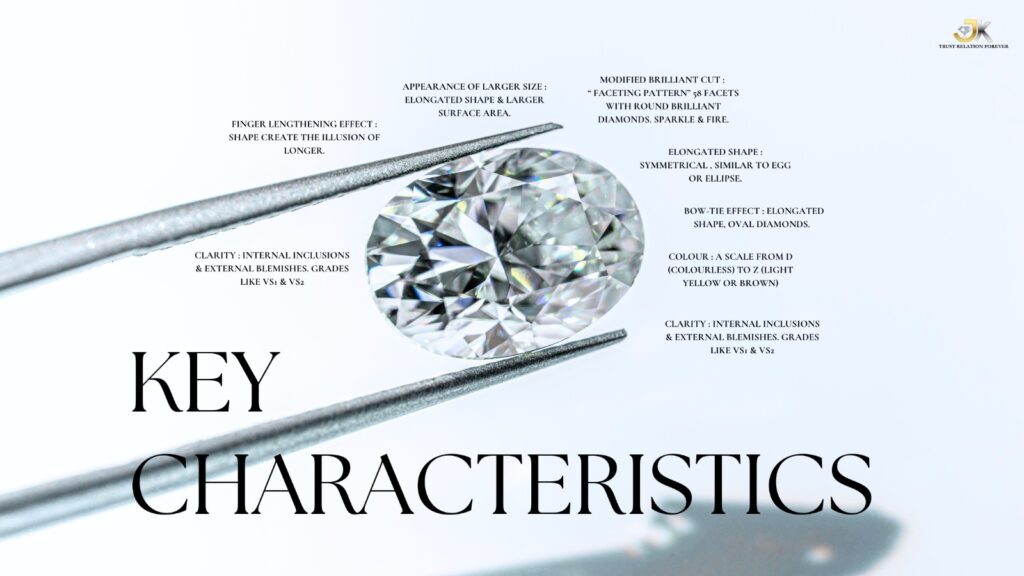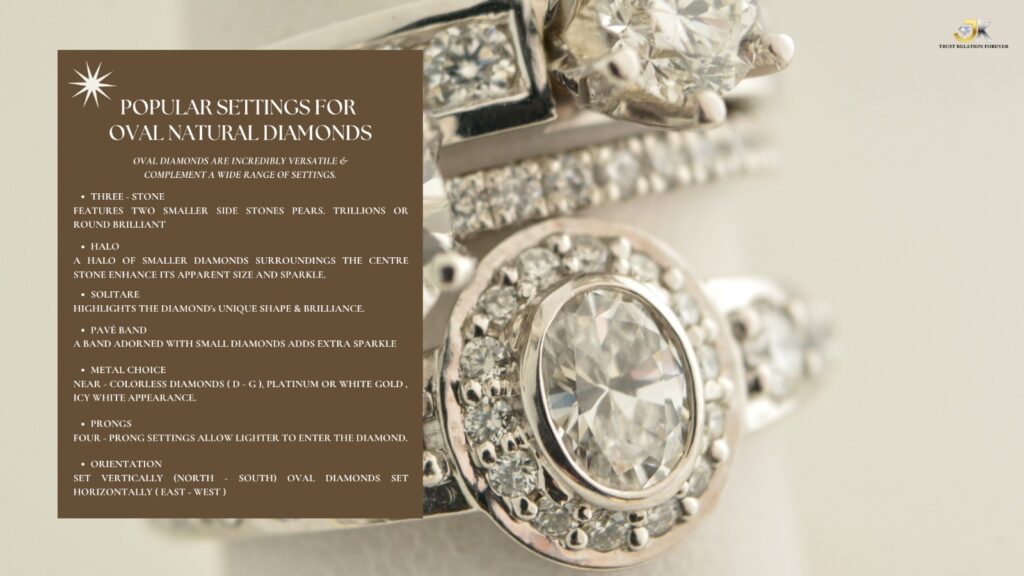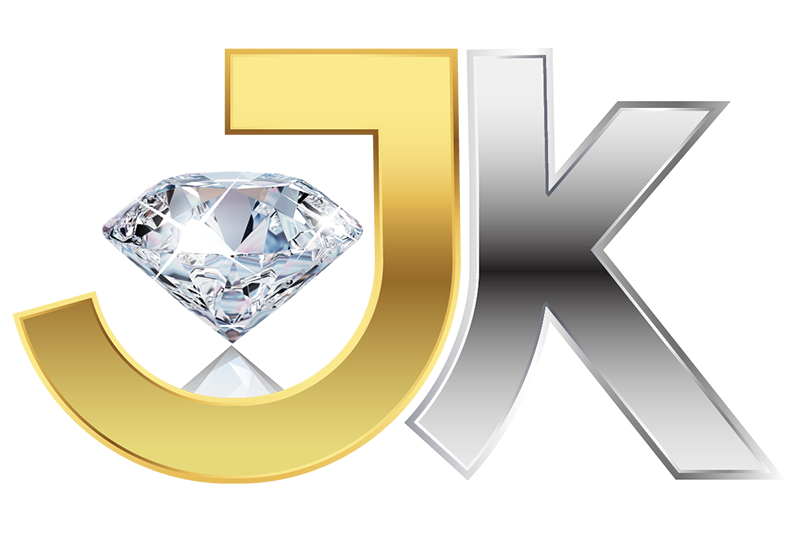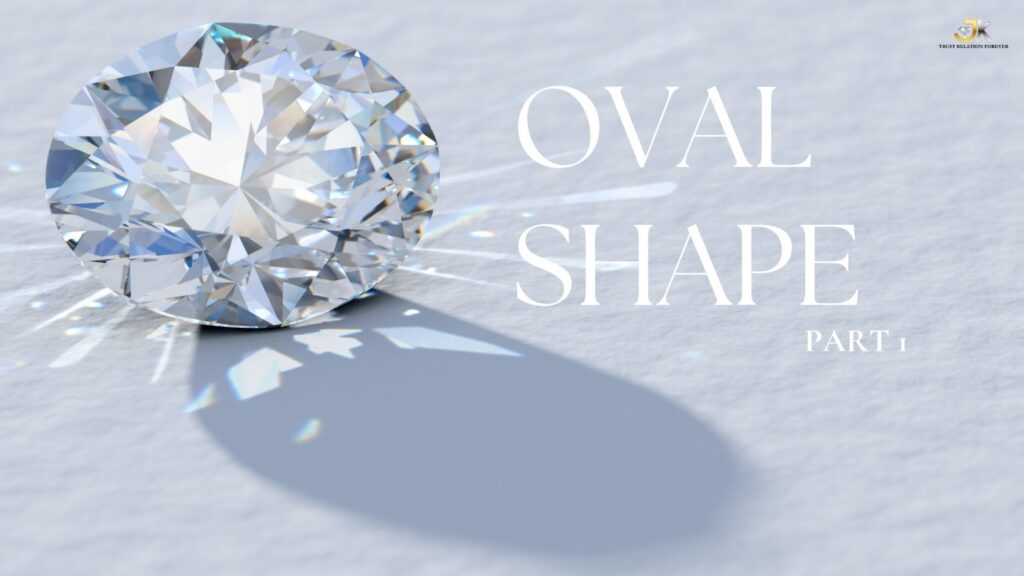An oval natural diamond combines the brilliant sparkle of a round diamond with an elegant, elongated shape. It’s a popular choice for engagement rings and other jewelry due to its unique appearance and ability to flatter the wearer’s hand.
Here’s a comprehensive look at oval natural diamonds:
Characteristics of Oval Natural Diamonds
- Modified Brilliant Cut: Oval diamonds are a “modified brilliant cut,” meaning they share a similar faceting pattern (typically 58 facets) with round brilliant diamonds, maximizing their sparkle and fire.
- Elongated Shape: Their symmetrical, elongated form gives them a distinct look, often compared to an egg or ellipse.
- Appearance of Larger Size: Due to their elongated shape and larger surface area, oval diamonds often appear larger than round diamonds of the same carat weight, offering excellent value for money.
- Finger Lengthening Effect: When worn, their elongated shape creates the illusion of longer, more slender fingers, making them a very flattering choice.
- Versatility: Oval diamonds are highly versatile and look stunning in various settings, from classic solitaires to more intricate halo or three-stone designs.

The 4 Cs of Oval Natural Diamonds
Like all natural diamonds, oval diamonds are graded based on the 4 Cs: Carat, Cut, Color, and Clarity.
- Carat: This refers to the diamond’s weight. As mentioned, an oval diamond can appear larger than a round diamond of the same carat weight due to its elongated shape.
- Cut: While GIA (Gemological Institute of America) does not provide a specific “cut grade” for fancy shapes like ovals, the quality of the cut is crucial for an oval diamond’s brilliance. Key factors influencing the cut include:
- Length-to-Width Ratio (L/W Ratio): This ratio determines how elongated or round the oval appears. Common preferences range from 1.30 to 1.60. A ratio around 1.50 is often considered traditional, while higher ratios result in a longer, thinner look.
- Table % and Depth %: These percentages relate to the diamond’s proportions and how effectively light is reflected. Optimal ranges for depth are generally 57%-67% and for table, 53%-65%.
- Bow-Tie Effect: Due to their elongated shape, oval diamonds can sometimes exhibit a “bow-tie” effect – a dark, unsparkling area across the center of the diamond. A well-cut oval will minimize or eliminate this.

- Color: Color is graded on a scale from D (colorless) to Z (light yellow or brown). Oval diamonds can show more of their color than round diamonds due to their shallower cut, so it’s often recommended to opt for a slightly higher color grade (e.g., G or H) to ensure a white appearance.
- Clarity: Clarity refers to the presence of internal inclusions and external blemishes. Oval diamonds, being brilliant cuts, are generally good at hiding minor inclusions due to their many facets and sparkle. Grades like VS1 and VS2 often offer excellent value for an eye-clean diamond.
Pricing and Value
Oval diamonds are generally less expensive than round brilliant diamonds of the same carat weight. This is because less rough diamond material is wasted when cutting an oval compared to a round. However, their increasing popularity can influence pricing. Factors like the 4 Cs, demand, and market trends all play a role in their cost.
Durability
Oval diamonds are relatively durable for daily wear because they lack sharp corners that are prone to chipping, unlike shapes like princess or marquise.
Popular Settings for Oval Natural Diamonds
Oval diamonds are incredibly versatile and complement a wide range of settings: - Solitaire: A classic and elegant choice that highlights the diamond’s unique shape and brilliance.
- Halo: A halo of smaller diamonds surrounding the center stone enhances its apparent size and sparkle.
- Three-Stone: Often featuring two smaller side stones (e.g., pears, trillions, or round brilliants), a three-stone setting can beautifully frame the oval center.
- Pavé Band: A band adorned with small diamonds adds extra sparkle and can draw attention to the oval.
- Metal Choice:
- For near-colorless diamonds (D-G), platinum or white gold enhances their icy white appearance.
- For diamonds with a slight yellowish tint (H-J), warmer metals like yellow or rose gold can help mask the color.
- Prongs: Four-prong settings allow lighter to enter the diamond, while six-prong settings offer increased security.
- Orientation: While typically set vertically (north-south) to maximize the lengthening effect, oval diamonds can also be set horizontally (east-west) for a unique and modern look.
History of Oval Natural Diamonds
While diamonds have been cut into ovular shapes for centuries (the famous Koh-I-Noor diamond, dating back to 1304, was an early oval), the modern oval brilliant cut we know today was perfected by Lazare Kaplan in 1957. Kaplan, a Russian-born diamond cutter, designed a facet structure that maximized light reflection, like the round brilliant, while retaining the unique elongated shape. This invention quickly gained popularity and established the oval as a fashionable and sought-after diamond cut.
Stay updated on the latest JK Sons postings by following us on Instagram.
https://www.instagram.com/j_ksons/
https://x.com/jksonsdiamond?t=a4_K1Uej1BwNCXt63jmEMw&s=08
https://www.youtube.com/@JKSons-q4x
https://www.facebook.com/share/19fYjZtEZf/
https://www.linkedin.com/in/jk-sons-a8005832b?utm_source=share&utm_campaign=share_via&utm_content=profile&utm_medium=android_app


